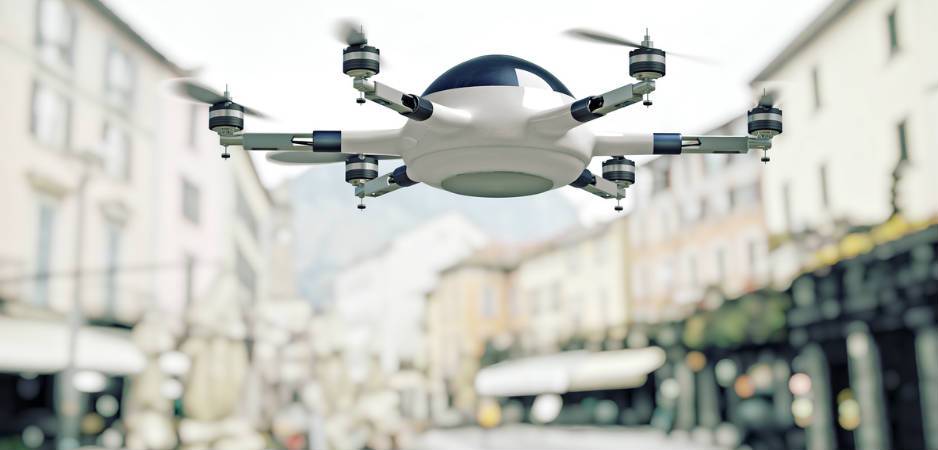The practical reality of using drones in cities remains far away and is getting ever more distant.
You may have gasped with disbelief the first time you saw a photograph of a drone home-delivering a box from Amazon or cakes from a bakery or carrying a bag of chips. Until recently, this was the stuff of science fiction. Your initial reaction was probably: “Amazing … but will it ever take off?”
Drones—or unmanned aerial vehicles, as we once called them—have now become capable of lifting and delivering on the back of continued research and technological ingenuity. Amazon has recently been trialing drones in Australia and the United Kingdom, but don’t get too excited: This is likely to be an exception rather than a norm. The practical reality of using drones in cities remains far away and is getting ever more distant.
There are already too many potential problems to let drones fly with sufficiently loose restrictions in cities to make a delivery business viable. One major issue is drones interfering with aircraft, thanks to surging numbers of near-misses. Drones are also increasingly being used to fly drugs and other contraband into prisons.
In the United States, there have been fears about camera-equipped drones stalking celebrities for paparazzi. There have also been stories about invasive drone surveillance, both on behalf of the state and private individuals.
Drone Law
The biggest backlog of legal cases in the US is reportedly of drone claims over issues including safety, noise, damage, personal intrusion and privacy. The whole area is a growing business for lawyers, with drone-law journals springing up and fierce debates over whether, for example, drones fall within the definition of aircraft for legal purposes.
New US flight rules introduced in August 2016 did lead some optimists to predict a new business opportunity that could create 100,000 new jobs, but the reality is that the whole sector is in a mess. The US Federal Aviation Authority has explicitly said drone deliveries are off limits, at least pending further research into their consequences.
At the same time, technologies are emerging that are designed to down drones. Your initial reaction might be that these will never work either, but I’m not so sure.
A great recent British engineering invention is the SkyWall100. It looks like a bazooka gun and uses laser-guided targeting to fire a ball. This opens into a net that engulfs the drone and brings it to earth under a parachute. It went on sale in late 2016 and is retailing at between £50,000 and £65,000 depending on the size of the order. So far, it has attracted a promising level of interest.
The SkyWall100 is safer and less messy than shooting down drones with bullets, yet it opens up a cavern of legal ambiguities. In the UK, for example, it’s classed as a firearm so can only be owned by someone with the appropriate licence—restricting them mainly to the police or military. The US has looser firearm restrictions, of course, but firearms still generally can’t be discharged within city limits. However, the SkyWall100 is not classified as a firearm in the US, so it can be discharged anywhere.
Among other techniques for taking out drones, one is the Battelle DroneDefender, which is a large gun that fires a “cone of energy” at a device that disrupts GPS systems. So far, these are only in use by the military and not permitted for public sale.
Going Down
If the likes of the SkyWall100 are going to let people prevent drones from moving over their private property to avoid their nuisance, noise and frankly hazard of failure, a new sport of “drone downing” could easily become extremely popular in the coming years—at least in America. Drone-downing raises the alluring prospect of capturing free booty if it strays illegally into your property. So what constitutes as illegal?
While I stress I am no lawyer, the US rules for protecting your drone from such potshots would appear to be as follows. It must weigh less than 25 kg and can’t be out of your line of sight or higher than 400ft in the air. It can only be flown in daylight, and at dawn and dusk it needs special lights to make it visible. It also can’t be flown over groups of people or near stadiums or airports.
In the UK, the rules are similar, but with slightly tougher weight restrictions and additional requirements—it must be at least 150 meters from a building and 50 meters from a person or vehicle. If I was planning to build a shopping or pizza delivery business based on using drones that delivered to homes in cities, restrictions like these would make me more than a little jittery.
Put all this together and it’s virtually impossible to see drone deliveries becoming viable in cities. It might be a different story in remote locations where special deliveries may be deemed acceptable and welcomed, but otherwise I’m afraid this is one vision of the future that has no chance of coming to pass. It is an example of a clearly brilliant concept that is colliding badly with human nature and reality.
*[This article was originally published by The Conversation.] ![]()
The views expressed in this article are the author’s own and do not necessarily reflect Fair Observer’s editorial policy.
Photo Credit: tiero
Support Fair Observer
We rely on your support for our independence, diversity and quality.
For more than 10 years, Fair Observer has been free, fair and independent. No billionaire owns us, no advertisers control us. We are a reader-supported nonprofit. Unlike many other publications, we keep our content free for readers regardless of where they live or whether they can afford to pay. We have no paywalls and no ads.
In the post-truth era of fake news, echo chambers and filter bubbles, we publish a plurality of perspectives from around the world. Anyone can publish with us, but everyone goes through a rigorous editorial process. So, you get fact-checked, well-reasoned content instead of noise.
We publish 2,500+ voices from 90+ countries. We also conduct education and training programs
on subjects ranging from digital media and journalism to writing and critical thinking. This
doesn’t come cheap. Servers, editors, trainers and web developers cost
money.
Please consider supporting us on a regular basis as a recurring donor or a
sustaining member.
Will you support FO’s journalism?
We rely on your support for our independence, diversity and quality.







